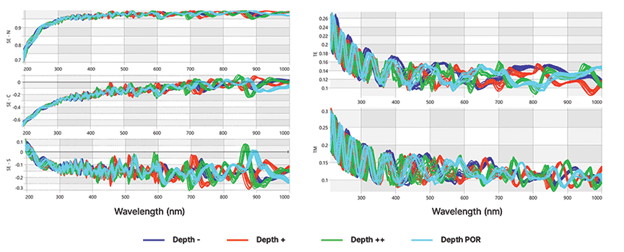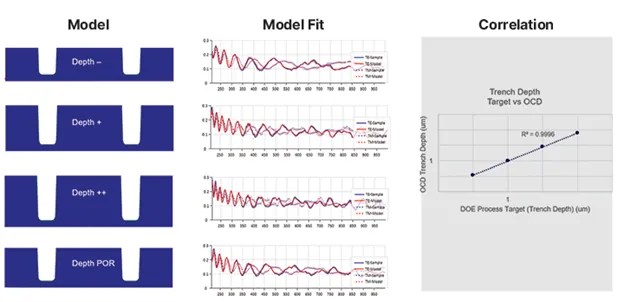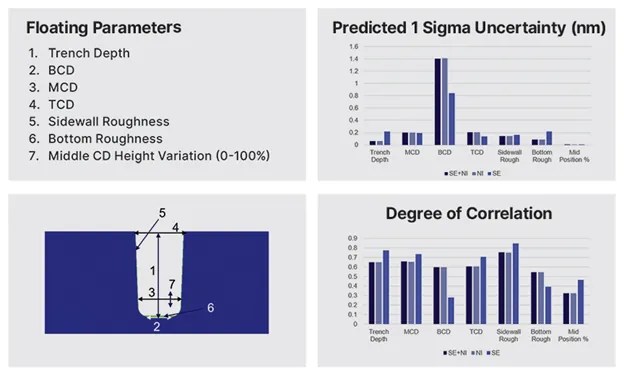You don’t have to be a dedicated follower of the transportation industry to know it is in the early stages of a significant transition, away from the rumbling internal combustion engine to the quiet days of electric vehicles. The signs of this transition are right there on the streets in the form of electric-powered buses, bikes and cars. The road to our electric future is before us, but we won’t be getting there without compound semiconductors like SiC.
Manufacturers in the automobile and clean energy sectors want more efficient power devices that can accommodate higher voltages, possess faster switching speeds and offer lower losses than traditional silicon-based power devices, something SiC power devices with trench structures can deliver.
But while trench-based architectures offer reduced on-resistance and increase carrier mobility, they bring along increased complexity. For manufacturers of SiC power devices, the ability to accurately measure epi layer growth and the depth of implant layers in these trenches is of considerable concern, especially when faced with ever-increasing fabrication complexity.
In the previous blog in this series, we explored how using an FTIR-based system allows for the direct modeling of carrier concentrations and film thickness, thus enabling SiC power device makers to better measure epi layer growth, implant layers and composition. In this installment, we explore how manufacturers of SiC power devices with trench-based structures measure trench depth and bottom and top critical dimension (CD) by using an optical critical dimension (OCD) metrology system designed for specialty devices.
The invisibility challenge
The core challenge when measuring SiC power devices with trench-based architectures is this: reentrant and vertically recessed structures are invisible to top-down metrologies. This applies to approaches like critical dimension scanning electron microscopy (CD-SEM) and image-based microscopy. As such, manufacturers have shifted to OCD for dimensional metrology. OCD offers non-destructive measurements that take less than a second, it is highly precise with angstrom-level repeatability, and it is a data rich metrology technique capable of measuring 10s of parameters simultaneously in complex 3D structures.
With OCD systems designed for the power device market, manufacturers often use spectroscopic ellipsometry (SE), the gold standard for thin film measurements, and polarized spectroscopic reflectometry (SR). SE is used to collect specular reflectance in the deep ultraviolet (DUV) to near-infrared (NIR) ranges from 2D and 3D periodic structures at oblique incidence, while with SR, it’s the same except at normal incidence. There is a downside to this: as an indirect method, OCD requires a model to interpret complex spectroscopic data. As a result, OCD metrology can be inaccurate and subject to long setup times. But, good news is here: model-guided machine learning (MGML) algorithms can improve accuracy and time to solution.
In our study, we used SE and SR to measure these trench-based structures in SiC power devices and then analyzed the data using RCWA-based EM solver. This information was then used to run advanced process control.
While OCD can be used at several process steps in the SiC trench MOSFET process flow, post-trench etch measurements are of particular interest. Trench etch is key because bottom width, bottom rounding, sidewall angle, depth and sidewall roughness contribute to key performance attributes, including breakdown voltage, on-resistance, channel mobility and time-dependent gate oxide breakdown. SiC etching is challenging because it is an extremely hard substance, chemically stable and has low selectivity to SiO2 hard masks.
Fig. 1: The spectral variation of the spectroscopic ellipsometry and normal incidence reflectometry OCD channels.
For the first application in our study, we processed a design of experiment (DOE) at the trench etch step on four wafers. The etch time was varied to skew the trench depth. Figure 1 shows the spectral variation of the SE and normal incidence reflectometry OCD channels, grouped by wafer, with a clear DOE. Figure 2 shows the physical model and the model fit to the experimental structure of the same site on the four wafers; it also shows the average trench depth versus the expected depth based on DOE conditions with excellent correlation.
Fig. 2: The physical model and the model fit to the experimental structure on the four DOE wafers.
For the second application, we expanded upon the trench structure in the previous example. While the previous DOE was focused on trench depth, the need to consider other key parameters in the model, including trench bottom width, were relevant, and, as such, needed to be measured. We then compared simulations using individual OCD channels, SE and SR, and both channels together (figure 3). By combining both channels, we were able to measure trench depth; the SE channel itself was used to measure bottom CD and top CD. As such, we determined that measuring all the key parameters impacting device yield and performance – including trench depth and bottom and top CD, at the trench etch step is possible using OCD metrology.
Fig. 3: A comparison of simulations using spectral ellipsometry (SE), normal incidence (NI), and combined SE and NI.
Conclusion
Without compound semiconductor power devices, the road ahead just might lead to a dead end. But SiC power device manufacturing poses several significant process control challenges, one of which is accurately measuring trench structures. Much like the FTIR-based systems discussed in our previous blog, “Using FTIR to Improve SiC Power Device Performance,” OCD metrology provides SiC power device manufacturers with several options to address these obstacles with certainty and clarity.
In our next blog, the final in this series, we will look at how picosecond ultrasonics can be used in trench-based SiC power device manufacturing. We hope you join us.
Nick Keller
Nick Keller has been with Onto Innovation since its founding in 2019 and prior to that Nanometrics, which merged with Rudolph Technologies to become Onto, since 2007. Keller is now a Director of Applications Development and has been instrumental in developing infrared critical dimension technology and providing pathfinding simulations in support of other new products at pre-initiation phases. He has seven issued patents and over 25 publications.
- SEO Powered Content & PR Distribution. Get Amplified Today.
- PlatoData.Network Vertical Generative Ai. Empower Yourself. Access Here.
- PlatoAiStream. Web3 Intelligence. Knowledge Amplified. Access Here.
- PlatoESG. Carbon, CleanTech, Energy, Environment, Solar, Waste Management. Access Here.
- PlatoHealth. Biotech and Clinical Trials Intelligence. Access Here.
- Source: https://semiengineering.com/using-ocd-to-measure-trench-structures-in-sic-power-devices/






